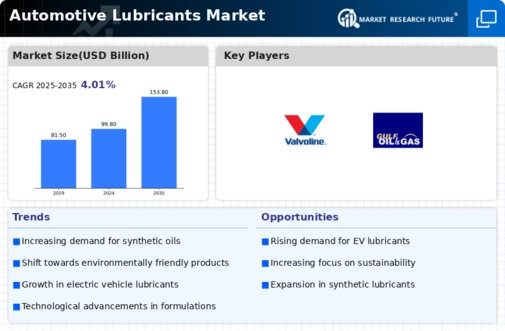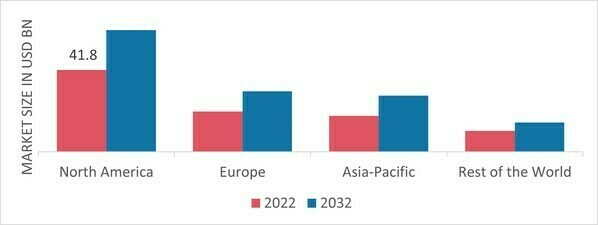-
Executive Summary
-
Market Introduction
-
Market Definition
-
Scope of the Study
-
List of Assumptions
-
Markets Structure
-
Market Research Methodology
-
Research Process
-
Primary Research
-
Secondary Research
-
Market Size Estimation
-
Forecast Model
-
Market Dynamics of the Global Automotive Lubricants Market
-
Introduction
-
Drivers
-
Restraints
-
Opportunities
-
Challenges
-
Trends/Technology
-
Market Factor Analysis of the Global Automotive Lubricants Market
-
Supply Chain Analysis
- Raw Material Suppliers
- Manufacturers/Producers
- Distributors/Retailers/Wholesalers/E-Commerce
- End Users
-
Porter’s Five Forces Analysis
- Threat of New Entrants
- Bargaining Power of Buyers
- Bargaining Power of Suppliers
- Threat of Substitutes
- Intensity of Competitive Rivalry
-
Pricing Analysis
-
Global Automotive Lubricants Market, by Material
-
Introduction
-
Mineral Oils
- Market Estimates & Forecast, 2023-2032
- Market Estimates & Forecast, by Region, 2023-2032
-
Synthetic Oils
- Market Estimates & Forecast, 2023-2032
- Market Estimates & Forecast, by Region, 2023-2032
-
Semi-Synthetic Oils
- Market Estimates & Forecast, 2023-2032
- Market Estimates & Forecast, by Region, 2023-2032
-
Bio-Based Oils
- Market Estimates & Forecast, 2023-2032
- Market Estimates & Forecast, by Region, 2023-2032
-
Global Automotive Lubricants Market, by Application
-
Introduction
-
Two Wheelers
- Market Estimates & Forecast, 2023-2032
- Market Estimates & Forecast, by Region, 2023-2032
-
Three Wheelers
- Market Estimates & Forecast, 2023-2032
- Market Estimates & Forecast, by Region, 2023-2032
-
Passenger Cars
- Market Estimates & Forecast, 2023-2032
- Market Estimates & Forecast, by Region, 2023-2032
-
Light Commercial Vehicles
- Market Estimates & Forecast, 2023-2032
- Market Estimates & Forecast, by Region, 2023-2032
-
Heavy Commercial Vehicles
- Market Estimates & Forecast, 2023-2032
- Market Estimates & Forecast, by Region, 2023-2032
-
Global Automotive Lubricants Market, by Product Type
-
Introduction
-
Engine Oil
- Market Estimates & Forecast, 2023-2032
- Market Estimates & Forecast, by Region, 2023-2032
-
Brake Oil
- Market Estimates & Forecast, 2023-2032
- Market Estimates & Forecast, by Region, 2023-2032
-
Gear Oil
- Market Estimates & Forecast, 2023-2032
- Market Estimates & Forecast, by Region, 2023-2032
-
Grease
- Market Estimates & Forecast, 2023-2032
- Market Estimates & Forecast, by Region, 2023-2032
-
Other Fluids
- Market Estimates & Forecast, 2023-2032
- Market Estimates & Forecast, by Region, 2023-2032
-
Global Automotive Lubricants Market, by Region
-
Introduction
-
North America
- Market Estimates & Forecast, 2023-2032
- Market Estimates & Forecast, by Material, 2023-2032
- Market Estimates & Forecast, by Application, 2023-2032
- Market Estimates & Forecast, by Product Type, 2023-2032
- US
- Canada
-
Europe
- Market Estimates & Forecast, 2023-2032
- Market Estimates & Forecast, by Material, 2023-2032
- Market Estimates & Forecast, by Application, 2023-2032
- Market Estimates & Forecast, by Product Type, 2023-2032
- Germany
- France
- Italy
- Spain
- UK
- Russia
- Poland
- Rest of Europe
-
Asia-Pacific
- Market Estimates & Forecast, 2023-2032
- Market Estimates & Forecast, by Material, 2023-2032
- Market Estimates & Forecast, by Application, 2023-2032
- Market Estimates & Forecast, by Product Type, 2023-2032
- China
- India
- Japan
- Australia & New Zealand
- Rest of Asia Pacific
-
Middle East & Africa
- Market Estimates & Forecast, 2023-2032
- Market Estimates & Forecast, by Material, 2023-2032
- Market Estimates & Forecast, by Application, 2023-2032
- Market Estimates & Forecast, by Product Type, 2023-2032
- GCC
- Israel
- North Africa
- Turkey
- Rest of Middle East & Africa
-
Latin America
- Market Estimates & Forecast, 2023-2032
- Market Estimates & Forecast, by Material, 2023-2032
- Market Estimates & Forecast, by Application, 2023-2032
- Market Estimates & Forecast, by Product Type, 2023-2032
- Brazil
- Mexico
- Argentina
- Rest of Latin America
-
Company Landscape
-
Introduction
-
Market Strategy
-
Key Development Analysis
-
(Expansion/Merger & Acquisition/Joint Venture/New Product Development/Agreement/Investment)
-
Company Profiles
-
ExxonMobil Corporation
- Company Overview
- Financial Updates
- Product/Business Segment Overview
- Strategy
- Key Developments
- SWOT Analysis
-
Chevron Corporation
- Company Overview
- Financial Updates
- Product/Business Segment Overview
- Strategy
- Key Developments
- SWOT Analysis
-
Fuchs
- Company Overview
- Financial Updates
- Product/Business Segment Overview
- Strategy
- Key Developments
- SWOT Analysis
-
ConocoPhillips Corporation
- Company Overview
- Financial Updates
- Product/Business Segment Overview
- Strategy
- Key Developments
- SWOT Analysis
-
BP PLC
- Company Overview
- Financial Updates
- Product/Business Segment Overview
- Strategy
- Key Developments
- SWOT Analysis
-
LUKOIL
- Company Overview
- Financial Updates
- Product/Business Segment Overview
- Strategy
- Key Developments
- SWOT Analysis
-
IDEMITSU Kosan Co., Ltd
- Company Overview
- Financial Updates
- Product/Business Segment Overview
- Strategy
- Key Developments
- SWOT Analysis
-
Royal Dutch Shell PLC
- Company Overview
- Financial Updates
- Product/Business Segment Overview
- Strategy
- Key Developments
- SWOT Analysis
-
PT Pertamina (Persero)
- Company Overview
- Financial Updates
- Product/Business Segment Overview
- Strategy
- Key Developments
- SWOT Analysis
-
Total
- Company Overview
- Financial Updates
- Product/Business Segment Overview
- Strategy
- Key Developments
- SWOT Analysis
-
Ashland Inc.
- Company Overview
- Financial Updates
- Product/Business Segment Overview
- Strategy
- Key Developments
- SWOT Analysis
-
LIQUI MOLY GmbH
- Company Overview
- Financial Updates
- Product/Business Segment Overview
- Strategy
- Key Developments
- SWOT Analysis
-
Gulf oil
- Company Overview
- Financial Updates
- Product/Business Segment Overview
- Strategy
- Key Developments
- SWOT Analysis
-
ROCOL
- Company Overview
- Financial Updates
- Product/Business Segment Overview
- Strategy
- Key Developments
- SWOT Analysis
-
American Synthol, Inc.
- Company Overview
- Financial Updates
- Product/Business Segment Overview
- Strategy
- Key Developments
- SWOT Analysis
-
Conclusion
-
LIST OF TABLES
-
Global Automotive Lubricants Market, by Region, 2023-2032
-
North America: Automotive Lubricants Market, by Country, 2023-2032
-
Europe: Automotive Lubricants Market, by Country, 2023-2032
-
Asia-Pacific: Automotive Lubricants Market, by Country, 2023-2032
-
Middle East & Africa: Automotive Lubricants Market, by Country, 2023-2032
-
Latin America: Automotive Lubricants Market, by Country, 2023-2032
-
Global Automotive Lubricants Material Market, by Regions, 2023-2032
-
North America: Automotive Lubricants Material Market, by Country, 2023-2032
-
Europe: Automotive Lubricants Material Market, by Country, 2023-2032
-
Table10 Asia-Pacific: Automotive Lubricants Material Market, by Country, 2023-2032
-
Table11 Middle East & Africa: Automotive Lubricants Material Market, by Country, 2023-2032
-
Table12 Latin America: Automotive Lubricants Material Market, by Country, 2023-2032
-
Table13 Global Automotive Lubricants Application Market, by Regions, 2023-2032
-
Table14 North America: Automotive Lubricants by Application Market, by Country, 2023-2032
-
Table15 Europe: Automotive Lubricants Application Market, by Country, 2023-2032
-
Table16 Asia-Pacific: Automotive Lubricants Application Market, by Country, 2023-2032
-
Table17 Middle East & Africa: Automotive Lubricants Application Market, by Country, 2023-2032
-
Table18 Latin America: Automotive Lubricants Application Market, by Country, 2023-2032
-
Table19 Global Automotive Lubricants Product Type Market, by Regions, 2023-2032
-
Table20 North America: Automotive Lubricants Product Type Market, by Country, 2023-2032
-
Table21 Europe: Automotive Lubricants Product Type Market, by Country, 2023-2032
-
Table22 Asia-Pacific: Automotive Lubricants Product Type Market, by Country, 2023-2032
-
Table23 Middle East & Africa: Automotive Lubricants Product Type Market, by Country, 2023-2032
-
Table24 Latin America: Automotive Lubricants Product Type Market, by Country, 2023-2032
-
Table25 Global Material Market, by Region, 2023-2032
-
Table26 Global Application Market, by Region, 2023-2032
-
Table27 Global Product Type Market, by Region, 2023-2032
-
Table28 North America: Automotive Lubricants Market, by Country
-
Table29 North America: Automotive Lubricants Market, by Material
-
Table30 North America: Automotive Lubricants Market, by Application
-
Table31 North America: Automotive Lubricants Market, by Product Type
-
Table32 Europe: Automotive Lubricants Market, by Country
-
Table33 Europe: Automotive Lubricants Market, by Material
-
Table34 Europe: Automotive Lubricants Market, by Application
-
Table35 Europe: Automotive Lubricants Market, by Product Type
-
Table36 Asia-Pacific: Automotive Lubricants Market, by Country
-
Table37 Asia-Pacific: Automotive Lubricants Market, by Material
-
Table38 Asia-Pacific: Automotive Lubricants Market, by Application
-
Table39 Asia-Pacific: Automotive Lubricants Market, by Product Type
-
Table40 Middle East & Africa: Automotive Lubricants Market, by Country
-
Table41 Middle East & Africa: Automotive Lubricants Market, by Material
-
Table42 Middle East & Africa: Automotive Lubricants Market, by Application
-
Table43 Middle East & Africa: Automotive Lubricants Market, by Product Type
-
Table44 Latin America: Automotive Lubricants Market, by Country
-
Table45 Latin America: Automotive Lubricants Market, by Material
-
Table46 Latin America: Automotive Lubricants Market, by Application
-
Table47 Latin America: Automotive Lubricants Market, by Product Type
-
LIST OF FIGURES
-
Global Automotive Lubricants Market Segmentation
-
Forecast Research Methodology
-
Five Forces Analysis of Global Automotive Lubricants Market
-
Value Chain of Global Automotive Lubricants Market
-
Share of Global Automotive Lubricants Market in 2023, by Country (%)
-
Global Automotive Lubricants Market, 2023-2032
-
Global Automotive Lubricants Market Size, by Material, 2023
-
Share of Global Automotive Lubricants Market, by Material, 2023-2032
-
Global Automotive Lubricants Market Size, by Application, 2023
-
Share of Global Automotive Lubricants Market, by Application, 2023-2032
-
Global Automotive Lubricants Market Size, by Product Type, 2023
-
Share of Global Automotive Lubricants Market, by Product Type, 2023-2032










Leave a Comment